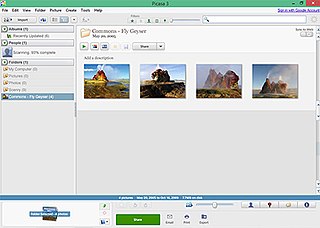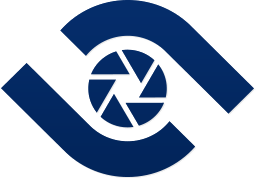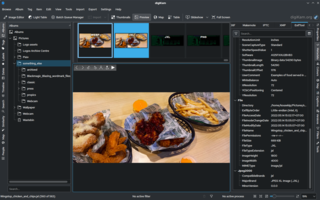Related Research Articles
CodedColor is a bitmap graphics editor and image organizer for computers running the Microsoft Windows operating system, and is published by 1STEIN.

Exchangeable image file format is a standard that specifies formats for images, sound, and ancillary tags used by digital cameras, scanners and other systems handling image and sound files recorded by digital cameras. The specification uses the following existing encoding formats with the addition of specific metadata tags: JPEG lossy coding for compressed image files, TIFF Rev. 6.0 for uncompressed image files, and RIFF WAV for audio files. It does not support JPEG 2000 or GIF encoded images.

An image viewer or image browser is a computer program that can display stored graphical images; it can often handle various graphics file formats. Such software usually renders the image according to properties of the display such as color depth, display resolution, and color profile.
The International Press Telecommunications Council (IPTC), based in London, United Kingdom, is a consortium of the world's major news agencies, other news providers and news industry vendors and acts as the global standards body of the news media.

Picasa was a cross-platform image organizer and image viewer for organizing and editing digital photos, integrated with a now defunct photo-sharing website, originally created by a company named Lifescape in 2002. "Picasa" is a blend of the name of Spanish painter Pablo Picasso, the word casa and "pic" for pictures.

In information systems, a tag is a keyword or term assigned to a piece of information. This kind of metadata helps describe an item and allows it to be found again by browsing or searching. Tags are generally chosen informally and personally by the item's creator or by its viewer, depending on the system, although they may also be chosen from a controlled vocabulary.
Desktop organizer software applications are applications that automatically create useful organizational structures from desktop content from heterogeneous types of content including email, files, contacts, companies, RSS news feeds, photos, music and chat sessions. The organization is based on a combination of automated scanning of metadata similar to data mining and manual tagging of content. The metadata stored in applications is correlated based on a structure for the data type handled by the organizer tool. For example, the email address of a sender of an email allows the email to be filed in a virtual folder for the author and company the author works for or a music file is filed by the musician and album label. The resulting visualization simplifies use of desktop content to navigate, search, and use related information stored on the desktop computer. The data in desktop organizer tools is normally stored in a database rather than the computer's file system in order to produce virtual folders where the same item can appear in multiple folders to the user based on its relationship to the folder.
digiKam is a free and open-source image organizer and tag editor written in C++ using the KDE Frameworks.
The Extensible Metadata Platform (XMP) is an ISO standard, originally created by Adobe Systems Inc., for the creation, processing and interchange of standardized and custom metadata for digital documents and data sets.

ACDSee is an image organizer, viewer, and image editor program for Windows, macOS and iOS, developed by ACD Systems International Inc. ACDSee was originally distributed as a 16-bit application for Windows 3.0 and later supplanted by a 32-bit version for Windows 95. ACDSee Pro 6 adds native 64-bit support. The newest versions of ACDSee incorporate modern Digital Asset Management tools like Face Detection & Facial Recognition.

XnView is an image organizer and general-purpose file manager used for viewing, converting, organizing and editing raster images, as well as general purpose file management. It comes with built-in hex inspection, batch renaming and screen capture tools. It is licensed as freeware for private, educational and non-profit uses. For other uses, it is licensed as commercial software.
Aperture is a discontinued professional image organizer and editor developed by Apple between 2005 and 2015 for the Mac, as a professional alternative to iPhoto.
Adobe Bridge is a free digital asset management app made by Adobe Inc. and first released with Adobe Creative Suite 2. It is a mandatory component of Adobe Creative Suite, Adobe eLearning Suite, Adobe Technical Communication Suite and Adobe Photoshop CS2 through CS6. Starting with Creative Cloud, however, it has become an optional component downloaded via Creative Cloud subscription.

An image organizer or image management application is application software for organising digital images. It is a kind of desktop organizer software application.
Phase One Media Pro was a commercial digital asset management cataloging program for Microsoft Windows and Apple OS X operating systems. It was the next version of iView MediaPro which Microsoft acquired in June 2006, and sold again in May 2010 to Phase One, which also makes the Capture One raw converter software. The software was aimed at professionals and photo enthusiasts who needed a photo manager which made it easier to manage photo and video assets, especially very large resolution image files and libraries with many items.

FastPictureViewer is a freemium image viewer for Windows XP and later. Its aim is to facilitate quick review, rating and annotation of large quantities of digital images in the early steps of the digital workflow, with an emphasis on simplicity and speed. As an app with a freemium license, a basic version is available cost-free for personal, non-profit or educational uses, while a commercial license is required for the professional version with additional features. The basic version starts as a full version trial.
The Information Interchange Model (IIM) is a file structure and set of metadata attributes that can be applied to text, images and other media types. It was developed in the early 1990s by the International Press Telecommunications Council (IPTC) to expedite the international exchange of news among newspapers and news agencies.
Fotki is a digital photo sharing, video sharing and media social network website and web service suite; it is one of the world's largest social networking sites. As an image hosting service, Fotki licenses photo-sharing software for global companies such as Telecom Italia, Alice.it, Sears, Mark Travel, Vegas.com, and Funjet.com, among others.
Upload components are software products that are designed to be embedded into a web site to add upload functionality to it. Upload components are designed to replace the standard HTML4 upload mechanism. Compared with HTML4, Upload Components have a more user-friendly interface and support a wider range of features.
References
- ↑ Clare Brandt (11 April 2012). "PicaJet FX review". PC Advisor. Retrieved 2013-01-13.
- ↑ Laura Delaney (June 30, 2004). "PicaJet 2.0 Review". PC Magazine. Retrieved 2012-04-05.
- 1 2 Clare Brandt (Apr 5, 2012). "Organize Photos Fast With PicaJet FX". PC World. Retrieved 2013-01-13.
- ↑ "Fotki Downloads" . Retrieved 2013-01-13.
- ↑ CNet staff (January 11, 2011). "PicaJet Review". CNet. Retrieved 2013-01-13.
- ↑ Steve Sanders (January 11, 2011). "PicaJet Benefits". Steve's Digicams. Retrieved 2013-01-13.
- ↑ Sue Chastain. "PicaJet Free Edition 2.5 - Digital Photo Software". About.com Guide. Retrieved 2013-01-13.